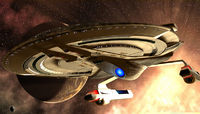The following auxiliary craft are assigned to the USS Discovery-B:
Personnel Shuttles
Type-8 Personnel Shuttlecraft
| Name
|
Status
|
Location
|
Mission Logs
|
|
|
Active
|
Deck 4 - Main Shuttlebay (Upper)
|
|
|
|
Active
|
Deck 4 - Main Shuttlebay (Upper)
|
|
|
- Aboard the Discovery Type-8s are traditionally named after
- Based upon the frame of the Type-6, the Type-8 Shuttlecraft is the most capable follow-up in the realm of personnel shuttles. Only slightly larger, the Type-8 is equipped with a medium-range transporter and has the ability to travel within a planet’s atmosphere. With a large cargo area that can also seat six passengers, the shuttle is a capable transport craft. Slowly replacing its elder parent craft, the Type-8 is now seeing rapid deployment on all medium to large starships, as well as to Starbases and stations throughout the Federation.
Type-9 Personnel/Scout Shuttlecraft
| Name
|
Status
|
Location
|
Mission Logs
|
|
|
Active
|
Deck 4 - Main Shuttlebay (Upper)
|
|
|
|
Active
|
Deck 4 - Main Shuttlebay (Upper)
|
|
|
- Aboard the Discovery Type-9s are traditionally named after
- The Type-9 Personnel Shuttle is a long-range craft capable of traveling at high warp for extended periods of time due to new advances in variable geometry warp physics. Making its debut just before the launch of the Intrepid-class, this shuttle type is ideal for scouting and recon missions, but is well suited to perform many multi-mission tasks. Equipped with powerful Type-VI phaser emitters, the shuttle is designed to hold its own ground for a longer period of time. Comfortable seating for four and moderate cargo space is still achieved without sacrificing speed and maneuverability. As is standard by the 2360’s, the shuttle is equipped with a medium-range transporter and is capable of traveling through a planet’s atmosphere. With its ability to travel at high-warp speeds, the Type-9 has been equipped with a more pronounced deflector dish that houses a compact long-range sensor that further helps it in its role as a scout. The Type-9 is now being deployed throughout the fleet and is especially aiding deep-space exploratory ships with its impressive abilities.

Type-11 Long Range Personnel Shuttlecraft
| Name
|
Status
|
Location
|
Mission Logs
|
|
|
Active
|
Deck 4 - Main Shuttlebay (Upper)
|
|
|
|
Active
|
Deck 4 - Main Shuttlebay (Upper)
|
|
|
- Aboard the Discovery Type-11s are traditionally named after
- With an ultimate goal towards creating a useful all-purpose shuttlecraft, the designers of the Type-11 Personnel Shuttle set out to create a craft that was equipped with all the systems of a starship within the shell of a relatively small shuttle. Allocation of the larger Danube-class runabout to starships in the field proved too costly, and with the expressed need by the Sovereign-class development team for a capable shuttle, the Type-11 was born. Its overall frame and components are a meshing of lessons learned in both the Type-9 and Danube-class vessels. Impressive shielding, several phaser emitters, micro-torpedo launchers and a capable warp propulsion system makes this shuttle capable of performing a multitude of tasks. Both the ventral and dorsal areas of the shuttle feature a new magnaclamp docking port that is capable of linking up to other ships similarly equipped. A two-person transporter and a large aft compartment with a replicator adds to the shuttle’s versatility. The end hope is that these all-purpose shuttles will replace the more specific-purpose crafts already stationed on starships, reducing the amount of space needed for shuttle storage in already-cramped bays. The Type-11 is now seeing selective deployment outside the Sovereign-class to further assess its capabilities in the field.

Workbee
| Name
|
Status
|
Location
|
Mission Logs
|
|
|
Active
|
Deck 4 - Main Shuttlebay (Upper)
|
|
|
|
Active
|
Deck 4 - Main Shuttlebay (Upper)
|
|
|
- Aboard the Discovery Workbee's are traditionally named after
- The Work Bee is a capable stand-alone craft used for inspection of spaceborne hardware, repairs, assembly, and other activates requiring remote manipulators. The fully pressurized craft has changed little in design during the past 150 years, although periodic updates to the internal systems are done routinely. Onboard fuel cells and microfusion generators can keep the craft operational for 76.4 hours, and the life-support systems can provide breathable air, drinking water and cooling for the pilot for as long as fifteen hours. If the pilot is wearing a pressure suit or SEWG, the craft allows for the operator to exit while conducting operations. Entrance and exit is provided by the forward window, which lifts vertically to allow the pilot to come and go.
A pair of robotic manipulator arms is folded beneath the main housing, and allows for work to be done through pilot-operated controls. In addition, the Work Bee is capable of handling a cargo attachment that makes it ideal for transferring cargo around large Starbase and spaceborne construction facilities. The cargo attachment features additional microfusion engines for supporting the increased mass.




